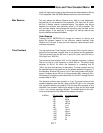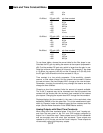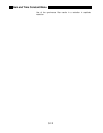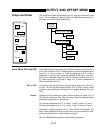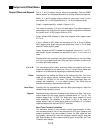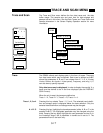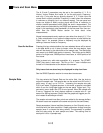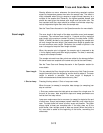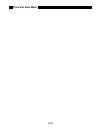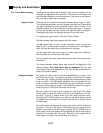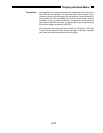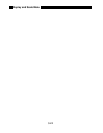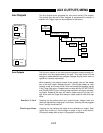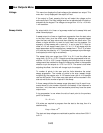
5-19
Trace and Scan Menu
Aliasing effects can occur whenever the trace being sampled contains
signals at frequencies greater than twice the sample rate. The effect is
most noticeable when trying to sample an output whose frequency is a
multiple of the sample rate. Generally, the highest possible sample rate
should be used given the desired scan length and the buffer size. The
time constant and filter slope should be chosen to eliminate output sig-
nals at frequencies higher than twice the sample rate.
See the Trace Scan discussion in the Operation section for more details.
Scan Length The scan length is the length of the data acquisition scan (and sweeps)
in seconds. The minimum scan length is 1 second and the maximum
scan length is the maximum number of points in the data buffer (16000,
32000, or 64000) divided by the sample rate. Changing the sample rate
will only change the scan length if the present scan length is greater than
the new maximum scan length. Otherwise, the number of points in the
scan is changed to keep the scan length constant.
When the sample rate is triggered, the sample rate is assumed to be
1 Hz for display scaling and scan length purposes. The time (in seconds)
is equal to the sample number.
The sample rate sets how often points are added to the storage buffers.
All stored traces are sampled at the same rate (and at the same times).
See the Trace Scan and Sweep discussion in the Operation section for
more details.
Scan Length This key selects the Scan Length as the active entry field. Enter the scan
length numerically from the keypad or use the knob to adjust it. The scan
length is entered in seconds. The scan length is displayed in
hours:minutes:seconds format below the entry field.
1 Shot or Loop Pressing this key selects 1 Shot or Loop scan mode.
When the scan (or sweep) is complete, data storage (or sweeping) can
stop or continue.
1 Shot scan mode means that data points are stored for a single scan. At
the end of the scan, data acquisition stops and swept parameters are
held at their final stop values.
Loop scan mode means that a new scan (or sweep) is started at the end
of each scan. Scans (and sweeps) repeat indefinitely until halted by the
user. The data buffer will store as many scans as possible. The buffer
always holds at least one complete scan. If the scan does not fill the
entire buffer, then multiple scans of data are stored. When the buffer is
full, new data is added at the beginning of the buffer, overwriting the
oldest data.



